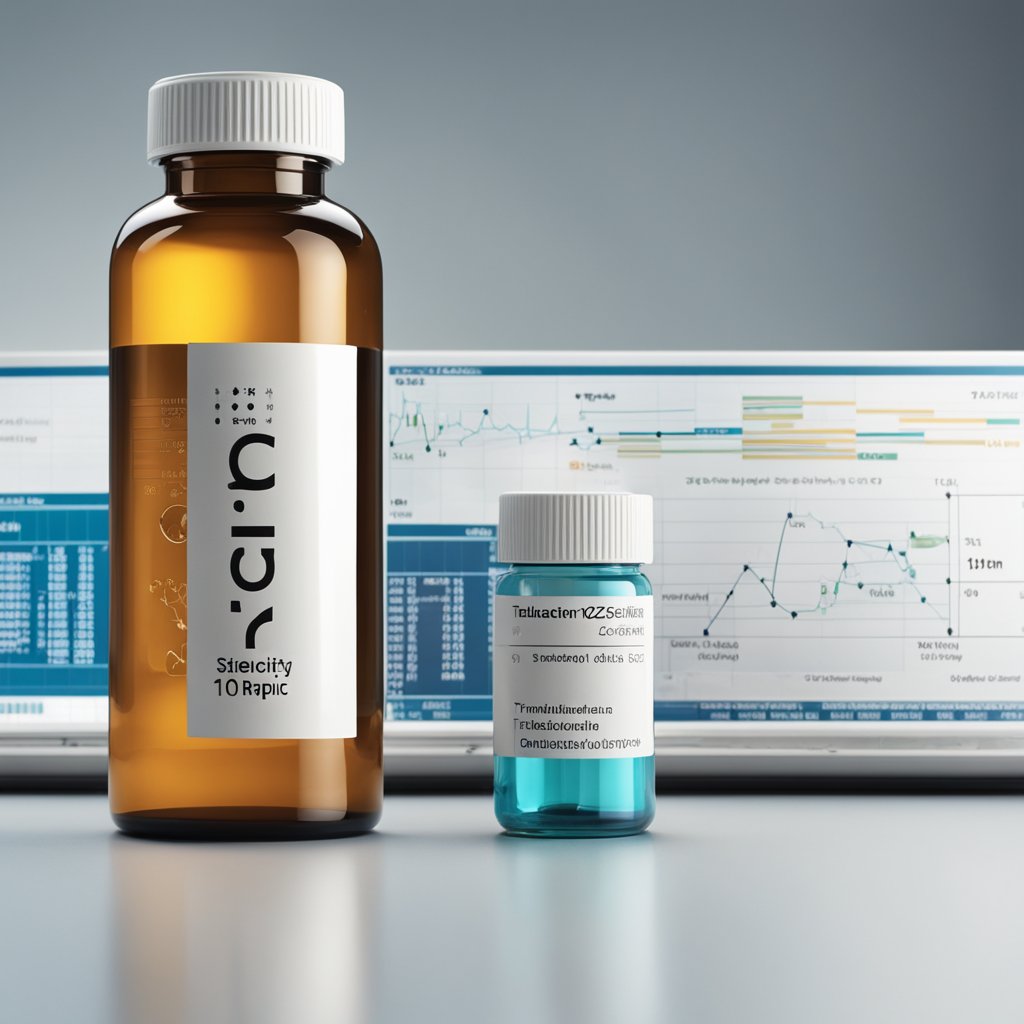In the landscape of type 2 diabetes management, medication choice is pivotal for effective blood sugar control and minimizing long-term complications. Two notable contenders in this category are Trulicity and Ozempic, both of which are GLP-1 agonists, a class of drugs that enhances insulin secretion in response to high blood sugar levels. I understand that patients and healthcare providers regularly compare Trulicity (dulaglutide) and Ozempic (semaglutide), as they have become leading options due to their efficacy and weekly dosing schedule.

While both medications function similarly by mimicking the incretin hormone GLP-1, there are nuances in their use and effects that are crucial for informed decision-making. Trulicity and Ozempic have shown promise in improving glycemic control, and studies have suggested benefits beyond blood sugar reduction, including weight loss and cardiovascular risk reduction. However, considerations regarding administration, dosage, side effects, and individual patient circumstances play a significant role in determining the most suitable choice for each person’s diabetes treatment plan. Understanding the nuances between these medications can empower patients with the knowledge to navigate their treatment options effectively.
Key Takeaways
- Trulicity and Ozempic are both GLP-1 agonists used for managing type 2 diabetes.
- They differ in administration, dosage, and potential side effects.
- Choice of medication depends on individual patient needs and health considerations.
Understanding Trulicity and Ozempic

In my examination of Trulicity (dulaglutide) and Ozempic (semaglutide), it’s crucial to note that both are glucagon-like peptide-1 (GLP-1) receptor agonists, a drug class used to improve blood sugar control in adults with type 2 diabetes.
Clinical Profiles
Trulicity and Ozempic have distinct clinical profiles that warrant attention. Trulicity, also known as dulaglutide, is commonly prescribed once a week. Studies indicate that Trulicity can improve glycemic control and has a potential benefit on cardiovascular outcomes. On the other hand, Ozempic, whose generic name is semaglutide, can also be taken once weekly and has shown to significantly reduce blood sugar levels with additional effects on weight loss and cardiovascular risk reduction.
Active Ingredients
The active ingredient in Trulicity is dulaglutide, while Ozempic contains semaglutide. Both are synthetic versions of the human incretin hormone GLP-1, and they work by enhancing glucose-dependent insulin secretion, suppressing glucagon secretion, and slowing gastric emptying.
Drug Classification
Trulicity and Ozempic Classification:
| Drug | Classification |
|---|---|
| Trulicity | GLP-1 agonist (dulaglutide) |
| Ozempic | GLP-1 agonist (semaglutide) |
Both drugs fall under the broader class of glucagon-like peptide-1 (GLP-1) receptor agonists. This drug class mimics the action of the natural hormone GLP-1, thereby improving the secretion of insulin in a glucose-dependent manner, which is critical for the management of type 2 diabetes.
Efficacy and Outcomes
In my review of Trulicity and Ozempic, I’ll examine their performance in key areas of treatment for type 2 diabetes, namely the impact on blood sugar levels, A1C reduction, and effects on weight loss.
Impact on Blood Sugar Levels
My analysis shows that both Trulicity (dulaglutide) and Ozempic (semaglutide) are designed to lower blood sugar levels in adults with type 2 diabetes. I’ll highlight the crucial aspect that these medications mimic the effects of GLP-1, a hormone that regulates blood sugar. Patients report reduced fasting blood sugar levels with the use of either medication. However, fine print data reveals that Ozempic might achieve a more significant reduction in blood sugar readings post-meals compared to Trulicity.
A1C Reduction
The primary goal in managing type 2 diabetes is the reduction of A1C. My findings draw from rigorous studies which have established that Trulicity and Ozempic effectively lower A1C levels. Clinical trial participants using Ozempic generally experience a slightly greater decrease in A1C compared to those on Trulicity. To illustrate, individuals on a higher dose of Ozempic may see an average A1C reduction of up to 1.5%, whereas Trulicity users typically note up to a 1.4% decrease.
Effects on Weight Loss
Weight loss is a beneficial side effect for those treating type 2 diabetes. I note that while both Trulicity and Ozempic can promote weight loss, the latter appears marginally more effective in this aspect. The mechanisms of action include delaying gastric emptying and reducing appetite, leading to reduced calorie intake. Through my research, I’ve observed patients treated with Ozempic losing up to 5-10% of their body weight, compared to a 2-3% weight loss with Trulicity. These figures are averages, and results can vary widely between individuals.
Administration and Dosage
Trulicity and Ozempic are both prescribed for the management of blood sugar levels in adults with type 2 diabetes, with administration and dosage being critical factors in their efficacy.
Modes of Injection
Trulicity is delivered through a once-weekly subcutaneous injection. I use a single-use pen that contains a pre-measured dose and does not require handling of needles. Simply, I select a site on my abdomen, thigh, or upper arm to administer the injection.
Conversely, Ozempic also uses a once-weekly subcutaneous injection. The method requires me to inject the dose from a prefilled pen with a replaceable needle. I must attach a new needle for each injection and dispose of it after use. I may inject into my abdomen, thigh, or upper arm, similar to Trulicity.
Dosage Comparison
The Trulicity doses available are as follows:
- 0.75 mg – Initial dosage
- 1.5 mg – Maintenance dosage
- 3 mg or 4.5 mg – May be considered if additional glycemic control is needed.
For Ozempic, the dosage progression is designed to help me minimize gastrointestinal side effects:
- 0.25 mg per week for the first four weeks (not for glycemic control)
- 0.5 mg per week for maintenance dose
- 1 mg per week if additional glycemic control is necessary
I must always consult my healthcare provider to determine the appropriate starting dose and any subsequent adjustments based on my medical condition and response to treatment. Both medications are titrated carefully to minimize side effects and optimize blood sugar control.
Potential Side Effects and Risks
In my experience with Trulicity and Ozempic, I’ve observed that while both medications are effective in managing type 2 diabetes, they carry potential side effects and risks that patients must consider.
Common Adverse Reactions
Trulicity:
- Nausea: In my clinical observations, many patients report mild to moderate nausea after initiating treatment.
- Diarrhea: Some individuals may experience episodes of diarrhea, which typically subside over time.
- Vomiting: Vomiting can occur but is less common compared to nausea.
Ozempic:
- Nausea: Similar to Trulicity, nausea is frequently reported by patients on Ozempic.
- Diarrhea: Diarrhea is also a common adverse reaction with this medication.
- Vomiting: While less frequent, vomiting can still affect some individuals taking Ozempic.
Serious Health Concerns
Trulicity:
- Pancreatitis: I always monitor my patients for signs of pancreatitis — a rare but serious inflammation of the pancreas.
- Thyroid Cancer: The potential risk of medullary thyroid carcinoma should be considered, although it is very rare.
- Retinopathy: Patients with a history of diabetic retinopathy must be closely watched as Trulicity might worsen this condition.
Ozempic:
- Pancreatitis: I advise patients always to be aware of potential symptoms of pancreatitis when on Ozempic.
- Thyroid Cancer: Although seldom observed, there’s a warning for thyroid C-cell tumors associated with Ozempic.
- Retinopathy: Diabetic retinopathy may progress, which I find essential to screen for regularly in my patients on Ozempic.
In both cases, I’ve noted that individuals with certain risk factors, like a history of pancreatitis or thyroid cancer, need closer monitoring for the mentioned serious health concerns. Hypoglycemia, especially when combined with other diabetes medications, is another risk I always warn patients on Trulicity and Ozempic to watch for.
Considerations for Treatment
When choosing between Trulicity and Ozempic for diabetes management, I consider not only the direct impact on blood glucose levels but also the broader implications on lifestyle and financial aspects.
Lifestyle and Diet
In terms of lifestyle and diet, both Trulicity and Ozempic are designed to improve blood glucose levels in conjunction with diet and exercise. I have observed that patients often report a decreased appetite, which can be beneficial for weight management—one of the critical components in treating type 2 diabetes. The medications are administered once weekly, which can fit conveniently into a patient’s routine, potentially improving adherence to the treatment plan.
- Diet: Incorporate a balanced diet that promotes stable blood glucose levels.
- Exercise: Regular physical activity is essential; aim for at least 150 minutes of moderate aerobic activity weekly.
Cost and Insurance
The cost of these medications can vary significantly, and insurance coverage is a primary concern for many of my patients. I’ve noticed that:
- Cost: Without insurance, both Trulicity and Ozempic can be quite expensive. Prices may change, but understanding the current cost landscape is crucial when planning treatment.
- Insurance: Coverage differs between insurance providers and plans. It’s important to check with the insurance company to see if they cover the chosen medication and what the out-of-pocket costs will be.
| Factor | Trulicity | Ozempic |
|---|---|---|
| Cost | Can be high without insurance | Can be high without insurance |
| Insurance | Coverage varies | Coverage varies |
| Blood Glucose | Primary Treatment Goal | Primary Treatment Goal |
| Appetite | Can cause decreased appetite | Can cause decreased appetite |
Patients need to evaluate their financial situation and discuss with their healthcare provider the most cost-effective strategy that does not compromise the efficacy of their diabetes management plan.
Frequently Asked Questions
In this section, I will address some of the most common questions regarding the comparison between Trulicity and Ozempic, with a focus on their aspects such as weight loss effects, costs, switching considerations, dosage differences, side effects, and alternative treatments.
What are the comparative weight loss effects of Trulicity and Ozempic?
Trulicity (dulaglutide) and Ozempic (semaglutide) are both GLP-1 receptor agonists used in the treatment of type 2 diabetes, but clinical studies suggest that Ozempic may lead to slightly greater weight loss in some patients compared to Trulicity.
How do the costs of Trulicity and Ozempic treatments compare?
The cost of Trulicity and Ozempic treatments can vary depending on insurance coverage and location. Generally, Ozempic has been known to be more expensive than Trulicity, but prices can change, and patient assistance programs may affect the out-of-pocket expenses.
What should be considered when switching from Trulicity to Ozempic?
When switching from Trulicity to Ozempic, it’s essential to consider factors such as the reasons for the switch (e.g., efficacy, tolerability), the potential differences in side effects, and the need for close monitoring of blood glucose levels to adjust the dose accordingly.
How do the dosages of Trulicity and Ozempic differ?
Trulicity is typically dosed once weekly with a pre-filled pen at varying doses, while Ozempic is also dosed once weekly but has a different dose escalation schedule to minimize gastrointestinal side effects. The dosages of both medications will be tailored to the individual’s needs by their healthcare provider.
What are the side effects associated with Trulicity and Ozempic?
Both Trulicity and Ozempic share similar side effects, such as nausea, vomiting, diarrhea, and abdominal pain. However, Ozempic may have a higher incidence of gastrointestinal side effects due to its stronger effect on delaying gastric emptying.
Are there any alternatives to Trulicity and Ozempic that are more effective for weight loss?
While Trulicity and Ozempic are effective for weight loss in the context of managing type 2 diabetes, there are alternative medications specifically approved for weight management, like GLP-1 agonists Wegovy (higher-dose semaglutide) or lifestyle changes and bariatric surgery procedures that might be considered in some cases. The effectiveness of these alternatives will depend on individual circumstances and medical advice.